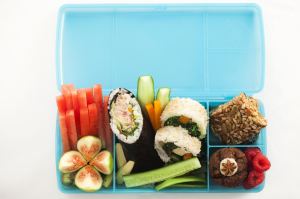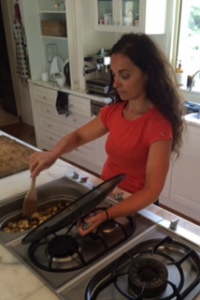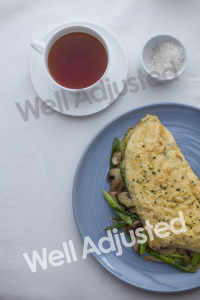 Celebrity chef Pete Evans has been promoting his new book, which advocates a paleo diet for children. This has prompted parents to email and ask me for my thoughts.
Celebrity chef Pete Evans has been promoting his new book, which advocates a paleo diet for children. This has prompted parents to email and ask me for my thoughts.
Let me be frank. I believe there is a significant link between our society’s reliance on grains as a staple food and the prevalence of health problems such as obesity and diabetes. As someone who struggles with gluten, I started listening to my body a long time ago and moved towards gluten-free grains. I then questioned the additives most gluten-free brands contained and so years before the paleo diet became popular I had minimised all grains in my diet.
Some would say I’m just ahead of the times. 🙂
Today I’m delighted by the paleo wave and that there is so much support available for people to minimise grains in their diet. This movement does however raise a lot of questions for parents and this week I have been sent a string of emails. Two popular questions have been:
Q: Do my children live the paleo lifestyle?
Q: What do you feed them?
Firstly the Paleo diet encourages people to go back to eating real, whole unprocessed foods including grass-produced meats, fish/seafood, fresh fruits and veggies, eggs, nuts and seeds and healthful oils such as olive, walnut, flaxseed, macadamia, avocado, coconut.
The Paleo lifestyle is exactly that more of a lifestyle then a diet. The focus is not to lose weight but to eat clean unprocessed foods that don’t tax the body. The following foods are avoided: cereal grains, legumes (including peanuts, dairy, refined sugar, potatoes, processed foods, salt and refined vegetable oils.
Secondly my children are NOT 100% paleo. While I focus on minimising refined sugar and processed foods, I have more flexibility about the boys having SOME organic grains and dairy at times.
Neither are my husband and I 100% paleo. Simon is part Italian and he flies the flag once every few weeks and indulges in some ciabatta, pizza or pasta. Does this mean that gluten or wheat agree with Simon and the boys?
No. It doesn’t.
As an isolated meal they fair okay. No tummy aches or bloating but give them a week with my mother or mother-in-law both of whom love white flour and they all start complaining after 2 or 3 days of digestive issues, bloating and tiredness.
Why?
The “modern wheat” found in most foods today has been significantly modified and altered from traditional forms of wheat.
Stop for a minute and consider the foods that you ate yesterday. Recall what you had for breakfast, lunch and dinner and the snacks that you grabbed as you headed out the door? Most people will have cereal and toast for breakfast, a biscuit or two for morning tea, a sandwich for lunch and their favourite pasta or rice dish for dinner. Grains are a quick and easy staple for many of us and they are, well, culturally ingrained into every meal of the day. We’ve been told for decades they are an incredibly important food group.
But consider this:
– Most modern wheat has been grown in nutrient deficient soils, sprayed, harvested, stored for many years, milled within an inch of its life. It is then bleached, processed, had ingredients added to it, it’s been packaged and stored in a warehouse and then stored again in a supermarket.
– When we consider that most wheat products contain mostly bleached white flour and they have had small amounts of liquids added and then additives, salt and sugar also added – to make them taste better. Then the sad reality is, when we eat white flour products such as bread, pasta, cakes, etc. we are simply eating an equivalent of the “Glue” or “Clag” repeatedly through the day!
This is why many of us react to today’s “completely lifeless wheat” with an array of symptoms that we may not even attribute to this modern variation of the traditional grain. “Wheat Belly” by William Davis MD makes for an insightful read.
In my opinion most wheat based products are simply bum glue and if you have digestive issues than the first factor to consider is, “How much bum glue do you eat in a day??”
Wheat products can also be responsible for those few extra kilos on our waists or backsides—remember that when farmers want to fatten up their cows what do they feed their cows?
Answer: Grains!
I think you’d agree – no pun intended but that’s good food for thought.
In Lunchbox Solutions, I discuss the health benefits of minimising grains and for the times that you wish to use grains, how to choose ‘quality’. We serve our children well to focus them on the benefits of eating protein and fruits and vegetables then allowing them to have a reliance on grains.
 Q: So what do “our” family’s – daily routine of meals look like?
Q: So what do “our” family’s – daily routine of meals look like?
JEN:
For me I love the paleo diet and I would say most of my week is probably 95% paleo. I happily gravitate to paleo dishes breakfast, lunch and dinner. I’m not however a staunch devotee, on occasion I may have yoghurt or butter. My philosophy is to listen to my body and if I intuitively feel that I need a particular food occasionally, then I have it.
For example when stressed my body intuitively craves “good fats” to calm my nervous system which I can attain through nuts and avocado but if I wanted to have some full fat organic yoghurt then I’m not going to beat myself up about that.
Why not coconut yoghurt you may ask? To be honest….I think I’m just sick of it!! I can’t even bring myself to eat it any more. 🙂
I also don’t stress when eating out if a protein and veg dish contains a small amount of dairy or if I’m eager to share a dessert with my groom that may contain gluten and dairy. Such is life occasionally.
SIMON:
On the days that Simon works from home he’s very happy to eat paleo meals, he may add some organic Kamut toast to his breakfast but typically that would be the only grain addition on these days. When in Melbourne he may choose grains but since turning forty….he’s very disciplined I must say!
BOYS:
With the boys I try to limit grains to one meal a day, two on a day that I haven’t planned very well. Parent to parent, I find it incredibly hard to do “paleo” all the time with school aged children!
There I said it. “It’s really hard.”
Sorry Pete Evans. Even though your book is wonderful and most of your recipes have been regular menu items in our house for a while, creating paleo breakfasts, lunches and dinners, seven days a week for four children – is beyond me.
Maybe if I had a ‘personal chef’ or surrendered to being a ‘personal chef’ all day, every day (to the exclusion of all other tasks) then I could have enough food prepared to satisfy their hunger. That’s the reality.
With four growing boys I find it incredibly hard to fill them up and I provide mountains of protein. Some experts would say that the boys must be hungry because they aren’t eating enough protein, that they are eating too many carbs. This is just NOT the case. I am the carb police!
My fridge is full of protein that I can cook or reheat, so there is no lack of protein in their day. The reality is they are just constantly growing and they do large amounts of structured and unstructured exercise everyday, so they burn through the fuel.
My mother-in-law often pipes up and tells me to just to let them eat toast every afternoon or just give them pasta every night. Thankfully for them I am averse to giving them too many grains SO FOOD IS A CONSTANT in my life and needless to say the boys are NOT 100% paleo.
I would say they are on average school day they are around 60-70% paleo and 80% over the weekends. This is one of the reasons that I wrote Lunchbox Solutions, to encourage parents to look beyond the humble sandwich and have children happily eat an array of lunchbox items. When children are used to eating a variety of foods then maintaining healthy habits is easy.
The boys are use to cauliflower mash and zucchuni noodles with pasta but some nights they simply want pasta or rice and if they haven’t had those dishes in a while, then I don’t make a big hoohar.
 Example of meal times in the Floreani household.
Example of meal times in the Floreani household.
We tend to have some type of egg dish 5-6 mornings a week. Seriously, we do. My organic grocer loves me and happily delivers boxes and boxes of eggs and produce to my door. We make eggs any style, grain-free pancakes, high protein smoothies, etc., the hilarious thing is the boys complain it I’m rushing and they have to have cereal! Therese Kerr and I are in the process of finishing Breakfast Solutions (a sequel to Lunchbox Solutions) because we both love “breakfast” more than any other meal in the day.
Depending on the morning though the boys may or may not, have toast with butter (so clearly not always very paleo). I also believe organic butter is a great health food, it’s an important fat that also nurtures gut health and while I don’t tend to eat bread, the boys do and butter with breakfast – is fine with me.
Breakfast: Scrambled eggs for breakfast with NO toast.
For morning tea and lunch at school: Fruit, nuts, a biscuit, veggie sticks, popcorn and a sandwich (salad and protein).
For afternoon tea: Soup, hummus, rice crackers, veggie sticks. Other alternatives include reheated protein leftovers from dinner the night before, or organic full fat yoghurt, nuts and fruit salad.
Dinner: Protein and vegetables or salad, which is always far more exciting than it sounds as I love to cook.
Another day may be:
Breakfast: Poached eggs, (homemade) baked beans and toast.
For morning tea and lunch at school: A fruit bun, fruit, veggie sticks and sushi (or a chicken drumstick and a mini quiche)
For afternoon tea: Grain-free protein pancakes for afternoon tea.
Dinner: Protein and vegetables or salad.
I think the focus needs to be large amounts of clean protein, vegetables, fruit and water in our day and less grains and processed foods. If we (or our children) have small amounts of grain or dairy in our day or week, then let’s ensure they are the highest quality products we can source.
I hope I’ve given those curious parents another useful perspective.
To read more of Jennifer’s thoughts on the paleo diet and children please see post “10 Points From Our Family Food Philosophy”
 . . . . .
. . . . .
In health and happiness
Jennifer
Bach. Chiropractic, Bach. App Clinical Science
Registered internationally, no longer practicing as a chiropractor in Australia.
For more information on Lunchbox Solutions click here






